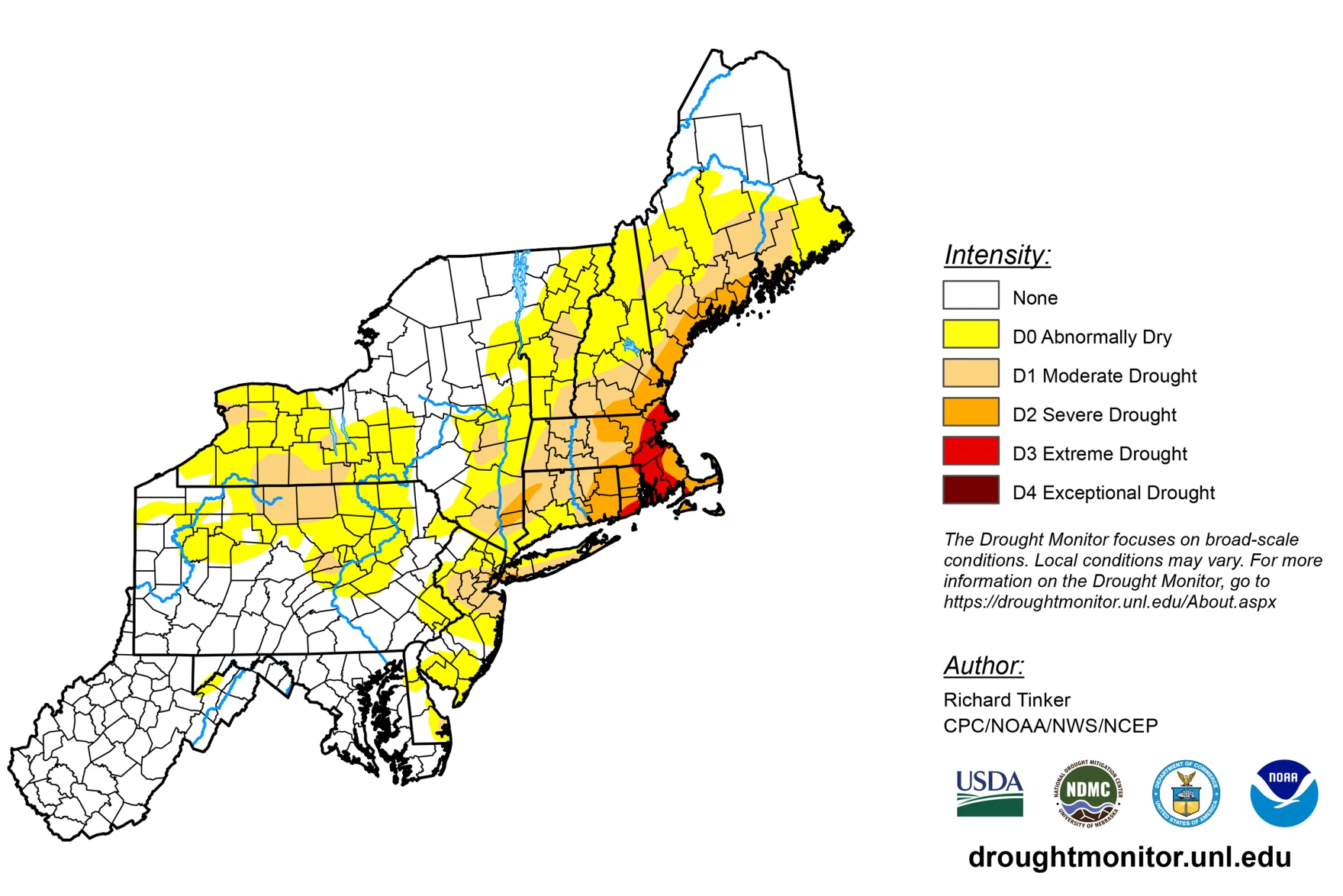Conservationists say New England’s drought is another wakeup call about climate change

Water levels well below normal flow through Eight Mile River in Devil’s Hopyard State Park in East Haddam, CT, Saturday, August 6. According to Alicea Charamut, Executive Director Rivers Alliance of Connecticut, “Flows on that day were less than 1 cfs (cubic feet per second.) This is well below 25th percentile flows of 1.9 cfs and significantly below the median flow of 4 cfs which are more typical flows for this time of year.” (Alicea Charamut / Rivers Alliance Of Connecticut Provided Photograph)
Alicea Charamut went for a hike last weekend to a place where she thought her dog would have a chance to cool off with a swim.
Devil’s Hopyard State Park, in East Haddam, Connecticut, has a big waterfall. But on this day, the water was barely flowing and Charamut’s dog found no relief.
“There was no part of the river, even in the deeper pools, that went anywhere past her knees,” Charamut said.
Across most of New England this summer, drought conditions have been worsening. Parts of Massachusetts and Rhode Island are now in extreme drought, according to the U.S. Drought Monitor.
Advocates, like Charamut, say we need to be talking more about climate change.
Charamut is the executive director of Rivers Alliance of Connecticut. She says most of the rivers and streams in her state are so low, they’re below the 25th percentile for streamflow.
She said people need to get out of the mindset of hoping for more rain.
“We have to think about what we can do to minimize the impacts further on down the line if we don’t get that precipitation,” she said, “because it’s not a guarantee.”
Lesley-Ann Dupigny-Giroux is Vermont’s state climatologist and a geography professor at the University of Vermont. She has been studying drought in the state for the past 25 years. She says this summer is reminding her of what we saw in 2020.
“Even back then, we were seeing record dry conditions in our groundwater wells, in our streams, and we’re seeing that happening again this year,” Dupigny-Giroux said.

The U.S. Drought Monitor is jointly produced by the National Drought Mitigation Center at the University of Nebraska-Lincoln, the United States Department of Agriculture, and the National Oceanic and Atmospheric Administration. Map courtesy of NDMC.
Vermont is the only New England state that’s not experiencing any severe drought right now. But Dupigny-Giroux says, even in her state, the issue is more serious than it seems.
She says all of New England is experiencing a long term drought.
“It also has to be regional, because the processes that drive a drought that is so severe, that you’re talking six states that are being critically affected, that didn’t happen overnight.”
Tia Pinney is a naturalist and teacher at the Massachusetts Audubon Society.
This summer, she’s seeing leaves browning and falling off trees earlier than normal at the Audubon’s education sites, and she’s worried that in future years, the trees and shrubs may not get enough moisture to make it through the year.
All of Massachusetts is abnormally dry, with about a quarter of the state now in extreme drought.
Pinney says climate change is an important part of her education programs, and a big focus of Mass Audubon’s advocacy in the state.
“How do we deal with the extremes and how do we deal with trying to mediate climate change so the extremes do not become more extreme? That’s what we’re focused on more than a response to the drought,” she said.
Alison Bowden, the director of conservation science and strategy at The Nature Conservancy in Boston, says her organization is also doing outreach on how drought is linked to climate change, and how that affects natural places in New England and tourists.
“If you’re coming here to fish, like so many people do, or if you’re coming here to eat oysters, those are both things that are going to be affected by the drought,” Bowden said.
Increased temperatures put stress on fish populations, Bowden says, and low river flow can increase the saltiness of coastal waters.
Julia Blatt, executive director of the Massachusetts Rivers Alliance in Cambridge, says she’s also been worrying about drought for a long time.
“This is actually the issue that started our organization, was low stream flow, and it’s only gotten more urgent as time has gone by,” she said.
Blatt says one of the most common ways we waste water is by watering our lawns. She says we need to prioritize water supply during droughts and throughout the year, and cultural ideas about what the grass should look like don’t help.
“As long as we continue to think that a home doesn’t look nice unless it has a bright green lawn all year round or all summer, we’re going to have some trouble conserving water,” Blatt said.

Water levels well-below normal flow through Chapman Falls in East Haddam, CT, Saturday, August 6. (Alicea Charamut / Photograph Provided By Rivers Alliance Of Connecticut)
